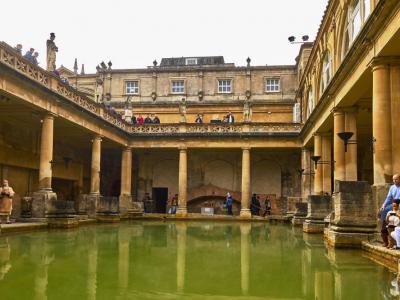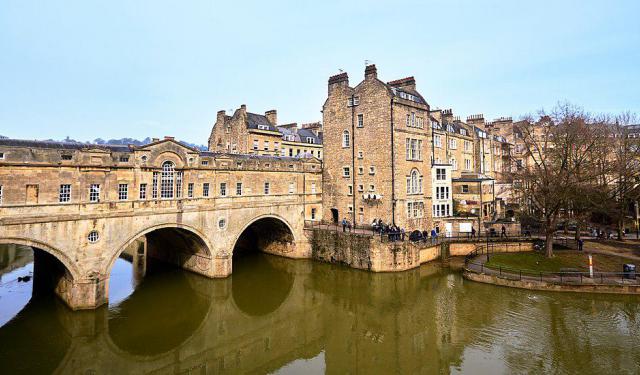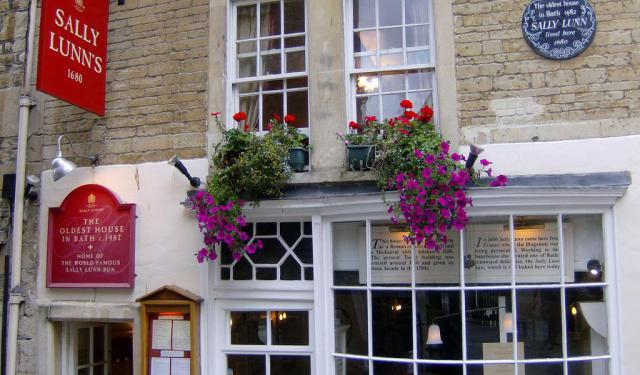Roman Baths, Bath (must see)
The Baths at Bath are fed by a natural spring system. Rain falls on the nearby Mendip Hills, and it flows down through limestone aquifers until it is more than 4,000 meters (13,100 feet) below ground level. Geothermal energy heats and pressurizes the water, which rises to the surface and escapes through natural fissures. The 46-degree Celcius (115-degree Fahrenheit) water bubbles up at more than a million liters (250,000 gallons) per day.
This natural spring has attracted visitors to the area for more than 2,000 years. The Celts worshiped here, and the early Romans dedicated the springs to the goddess Sulis. As such, the Roman name of the town was Aquae Sulis. It is also believed that pre-Roman British king Bladud built the original baths here and that their healing powers cured him and his pigs of leprosy.
Between 60 and 70 AD, the Roman temple was built. The Baths, or thermae, were created over the next 300 years or so. After the Romans withdrew from Britain, their complex fell into disrepair and was gone by the 6th century.
Today the spring is housed inside an 18th-century building designed by John Wood, the Elder, and John Wood, the Younger. The buildings were further expanded during the Victorian era in a similar style. The main entrance is currently through the Grand Pump Room, where visitors drank the waters and many social functions were held.
Why You Should Visit:
The Roman Baths intricately connect all points of Britain's history. The natural spring has been worshipped or visited by every resident and conqueror to pass; a visit to the Baths is a walk through time. The Baths are quintessentially unique to this location, and no visit to Bath would be complete without taking the waters, so to speak.
The site is one of the most popular tourist attractions and one of the finest historical sites you can visit in northern Europe. It is remarkably well preserved, with elements on display from each phase of its history.
Tips:
The museum is the place to go to learn the history of the Baths. There you will find thousands of Roman artifacts from the area, many thrown in the spring as an offering to Sulis.
Most people spend from two to three hours to a half-day touring the Baths and museum.
Unfortunately, you can no longer swim in the Baths. But there are several smaller spas nearby that capitalize on the same spring system, and aquifer-drawn water is still served in the Grand Pump Room.
This natural spring has attracted visitors to the area for more than 2,000 years. The Celts worshiped here, and the early Romans dedicated the springs to the goddess Sulis. As such, the Roman name of the town was Aquae Sulis. It is also believed that pre-Roman British king Bladud built the original baths here and that their healing powers cured him and his pigs of leprosy.
Between 60 and 70 AD, the Roman temple was built. The Baths, or thermae, were created over the next 300 years or so. After the Romans withdrew from Britain, their complex fell into disrepair and was gone by the 6th century.
Today the spring is housed inside an 18th-century building designed by John Wood, the Elder, and John Wood, the Younger. The buildings were further expanded during the Victorian era in a similar style. The main entrance is currently through the Grand Pump Room, where visitors drank the waters and many social functions were held.
Why You Should Visit:
The Roman Baths intricately connect all points of Britain's history. The natural spring has been worshipped or visited by every resident and conqueror to pass; a visit to the Baths is a walk through time. The Baths are quintessentially unique to this location, and no visit to Bath would be complete without taking the waters, so to speak.
The site is one of the most popular tourist attractions and one of the finest historical sites you can visit in northern Europe. It is remarkably well preserved, with elements on display from each phase of its history.
Tips:
The museum is the place to go to learn the history of the Baths. There you will find thousands of Roman artifacts from the area, many thrown in the spring as an offering to Sulis.
Most people spend from two to three hours to a half-day touring the Baths and museum.
Unfortunately, you can no longer swim in the Baths. But there are several smaller spas nearby that capitalize on the same spring system, and aquifer-drawn water is still served in the Grand Pump Room.
Want to visit this sight? Check out these Self-Guided Walking Tours in Bath. Alternatively, you can download the mobile app "GPSmyCity: Walks in 1K+ Cities" from Apple App Store or Google Play Store. The app turns your mobile device to a personal tour guide and it works offline, so no data plan is needed when traveling abroad.
Roman Baths on Map
Sight Name: Roman Baths
Sight Location: Bath, England (See walking tours in Bath)
Sight Type: Attraction/Landmark
Guide(s) Containing This Sight:
Sight Location: Bath, England (See walking tours in Bath)
Sight Type: Attraction/Landmark
Guide(s) Containing This Sight:
Walking Tours in Bath, England
Create Your Own Walk in Bath
Creating your own self-guided walk in Bath is easy and fun. Choose the city attractions that you want to see and a walk route map will be created just for you. You can even set your hotel as the start point of the walk.
Bath Introduction Walking Tour
The only English city designated a UNESCO World Heritage site, Bath is a gorgeous city packed with history. Artifacts have been found from the Bronze and Iron Age in the surrounding hills. The Romans were the first to build around the remarkable hot mineral springs at the beginning of the first century. They constructed a temple and baths here, and since then, people have flocked to Bath for its... view more
Tour Duration: 2 Hour(s)
Travel Distance: 2.5 Km or 1.6 Miles
Tour Duration: 2 Hour(s)
Travel Distance: 2.5 Km or 1.6 Miles
Historical Homes Walking Tour
Apart from its Roman thermae, the city of Bath is renowned for its prominent residents who used to live here a long time ago. Their former dwellings – historical monuments in their own right – now offer a captivating glimpse into the city's glorious past.
Among the most famous of them, undoubtedly, is the Jane Austen Centre. This charming Georgian townhouse provides a fascinating look... view more
Tour Duration: 1 Hour(s)
Travel Distance: 1.6 Km or 1 Miles
Among the most famous of them, undoubtedly, is the Jane Austen Centre. This charming Georgian townhouse provides a fascinating look... view more
Tour Duration: 1 Hour(s)
Travel Distance: 1.6 Km or 1 Miles
Jane Austen Walking Tour
Jane Austen, 1775-1817, was a renowned British author. Her groundbreaking novels offer a witty and humorous look at Regency-era life. Austen's six novels have since inspired many popular TV adaptations and films.
Jane Austen lived in Bath from 1801 to 1806. Two of her novels, Northanger Abbey and Persuasion, were set in this beautiful Georgian city. While interiors have certainly been... view more
Tour Duration: 2 Hour(s)
Travel Distance: 2.5 Km or 1.6 Miles
Jane Austen lived in Bath from 1801 to 1806. Two of her novels, Northanger Abbey and Persuasion, were set in this beautiful Georgian city. While interiors have certainly been... view more
Tour Duration: 2 Hour(s)
Travel Distance: 2.5 Km or 1.6 Miles
Georgian Architecture Walking Tour
Another prominent attraction of Bath is its wonderful Georgian architecture. Many a street and square here are richly adorned with distinctively stylish buildings. In large part, the city owes it to two architects – father and son: John Wood, the Elder, and John Wood, the Younger. Constructed mostly from Bath Stone, a creamy limestone obtained in Combe Down and Bathampton Down Miles, these... view more
Tour Duration: 1 Hour(s)
Travel Distance: 2.2 Km or 1.4 Miles
Tour Duration: 1 Hour(s)
Travel Distance: 2.2 Km or 1.4 Miles







